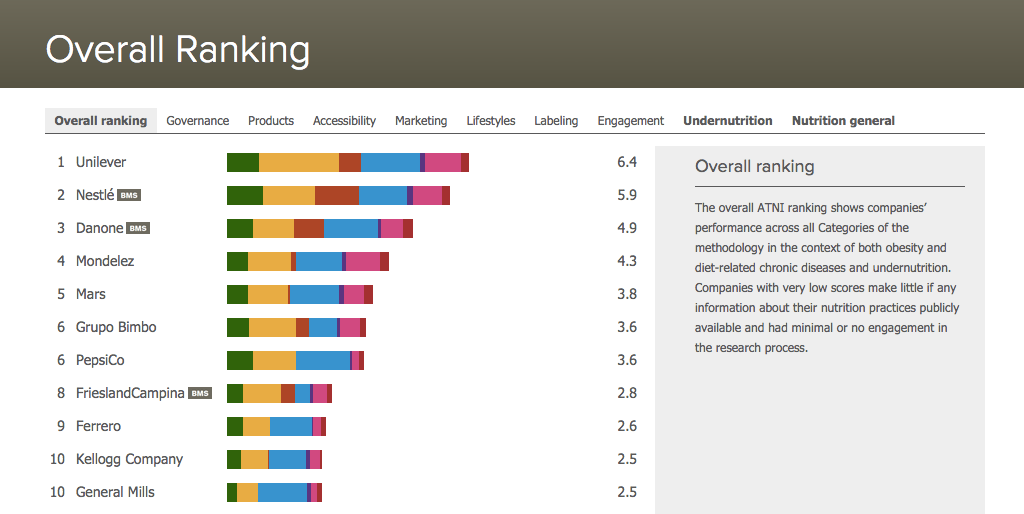
Obesity is a global problem. In 2014, 39 percent of adults 18 years old or older were overweight and 13 percent were obese, according to the World Health Organization (WHO). The majority of the world’s population live in countries where being overweight or obese kills more people than being underweight.
Food and beverage companies can play a big role in reducing obesity or the rate of overweight people. The 2016 Global Access to Nutrition Index ranked the 22 largest companies for their contributions to dealing with obesity and under-nutrition. The first rankings occurred in 2013 and 19 of the 25 companies assessed then are in the current Index, plus three new companies. Each of the 22 companies was rated on a scale of 0 to 10 based on their commitments, practices and disclosures relating to seven categories. The categories include: governance, products, accessibility, marketing, lifestyles, labeling, and engagement.
How much improvement has there been in three years? Unfortunately, not enough. Although the Index acknowledges that the 22 companies assessed “have improved their contributions to improving consumers’ diets,” they have a “long way to go if they are to play their full part in tackling the global nutrition crisis.” While eight companies improved their ranking, six fell this year, and five stayed the same.
There is one area where companies “showed no measurable improvement.” That area is an overall commitment to market responsibly to children. No company scored over 6.4 out of 10 in that area, and that is concerning considering that in 2013 the estimated global number of children under five who were overweight was over 42 million. Nearly 31 million of those children are in developing countries.
Here are the improvements the companies have made:
- Some have increased health and nutrition issues in their corporate strategies.
- Some have made commitments to improving the nutritional quality of some of their products.
- Some have introduced healthier options while others have both adopted and established “reasonably comprehensive” back-of-pack labels.
Three companies emerged as the leaders of the pack
Three companies lead the 2016 Index: Unilever, Nestlé and Danone. They also led the 2013 index. The three companies “still have a long way to go,” the index states, but “have clearly embedded a commitment to addressing global nutrition challenges into their core business models.”What makes these companies leaders? Take Unilever which the index says leads in providing healthier products to its global consumers and has a “strong” Nutrient Profiling System it uses for its global product portfolio to check for levels of key nutrients. Unilever defines nutrient profiling as the “categorization of foods for specific purposes, according to their nutritional composition.” What the company does is create profiles by assigning values to certain nutrients such as sugar, sodium or saturated fat. Then, it can use the nutrient profiles to determine the nutritional quality of food products to decide how to market them, but also for product reformulation, nutrition labelling, and health or nutrition claims.
Nestlé is a leader because it “stands out with a clear corporate nutrition strategy,” the Index states. That strategy includes a “comprehensive set of objectives” covering product reformulation to make them healthier and access to healthy foods plus responsible marketing. Part of Nestlé’s strategy are commitments it aims to meet by 2020 or sooner. Some of the commitments include:
- Leading the industry in nutrition and health research through collaboration.
- Providing nutritionally sound products designed for children.
- Reducing sugar, sodium, and saturated fats in its products.
- Removing trans fats in its products.
- Providing portion guidance for consumers.
At the other end of the pack were companies that "make very little information about their nutrition practices publicly available and had minimal or no engagement in the research process" -- Wahaha and Tingyi -- both Chinese companies. Tingyi is a leader in the manufacture of instant noodles. Kraft and Heinz scored slightly better, 18th and 19th out of 20, respectively. Clearly information and education are key components of malnutrition and obesity engagement, but one hopes for nutritious products as well. Click here to read the full rankings.

Gina-Marie is a freelance writer and journalist armed with a degree in journalism, and a passion for social justice, including the environment and sustainability. She writes for various websites, and has made the 75+ Environmentalists to Follow list by Mashable.com.














